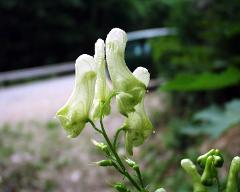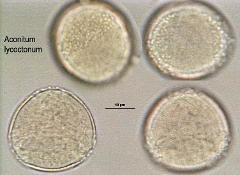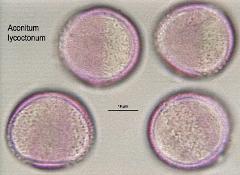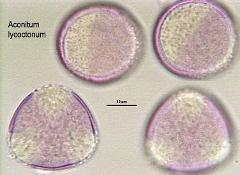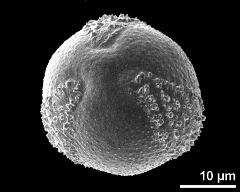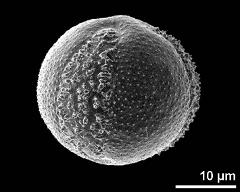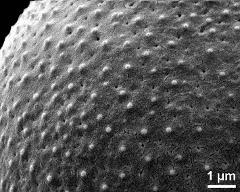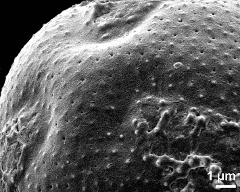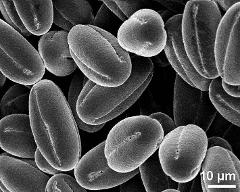Aconitum lycoctonum
Taxonomy: Angiospermae, Ranunculales, Ranunculaceae, Aconitum
Links: http://flora.nhm-wien.ac.at/Seiten-Arten/Aconitum-lycoctonum-vulp.htm
Published: 2020-11-10
Pollen Description
Shape, Size and Aperture
pollen unit: monad, dispersal unit and peculiarities: monad, size (pollen unit): medium-sized (26-50 µm), size of hydrated pollen (LM): 26-30 µm, shortest polar axis in equatorial view (LM): 26-30 µm, longest polar axis in equatorial view (LM): 26-30 µm, shortest diameter in equatorial or polar view (LM): 26-30 µm, longest diameter in equatorial or polar view (LM): 26-30 µm, pollen class: colpate, polarity: isopolar, P/E-ratio: -, shape: spheroidal, outline in polar view: circular, dominant orientation (LM): oblique, P/E-ratio (dry pollen): prolate, shape (dry pollen): -, outline in polar view (dry pollen): lobate, infoldings (dry pollen): aperture(s) sunken, aperture number: 3, aperture type: colpus, aperture condition: colpate, tricolpate, aperture peculiarities: aperture membrane ornamented
Ornamentation and Structure
LM ornamentation LM: psilate, nexine: -, sexine: -, SEM ornamentation SEM: microechinate, perforate, suprasculpture SEM: -, TEM tectum: -, infratectum: -, foot layer: -, endexine: -, intine: -, wall peculiarities: -, supratectal element: -
Miscellaneous
pollen coatings: -, reserves in cytoplasm: -, cell number: -, Ubisch bodies: present
Author(s) of diagnosis: Halbritter, Heidemarie; Heigl, Helmut
Pictures
Picture legend
- flower(s), photographer: Halbritter, H.
- hydrated Pollen - fresh, glycerine, unstained, photographer: Heigl, H.
- hydrated Pollen - fresh, glycerine, ruthenium red, photographer: Heigl, H.
- hydrated Pollen - fresh, glycerine, ruthenium red, photographer: Heigl, H.
- polar view - fresh, rehydrated (water) & critical point dried & sputter coated with gold, photographer: Halbritter, H.
- equatorial view - fresh, rehydrated (water) & critical point dried & sputter coated with gold, photographer: Halbritter, H.
- detail of aperture - fresh, rehydrated (water) & critical point dried & sputter coated with gold, photographer: Halbritter, H.
- exine surface - fresh, rehydrated (water) & critical point dried & sputter coated with gold, photographer: Halbritter, H.
- polar area - fresh, rehydrated (water) & critical point dried & sputter coated with gold, photographer: Halbritter, H.
- dry pollen grains - dry, sputter coated with gold, photographer: Halbritter, H.
Literature
- (1983) Studies in the pollen morphology of some cultivated Angiosperms Adv Pollen - Spore Res 11: 67 pp, 13 pl, 51 figs
- (1842) Memoir to determine the use of pollen in natural classification. J Bot 1: 575-601
- (1984) A practical pollen guide to the British flora. Quaternary Res Bull Technical Guide I: 1-139
- (1971) Atlas des pollens des environs d'Istanbul. Istanbul Universitesi, Orman Fakultesi publication : 1-330
- (1991) The Northwest European Pollen Flora, 51. Ranunculaceae. Rev Palaeobot Palynol 69: 117-271
- (1974) Schede per una flora palinologica italina. Not Fitosoc 8: 97-127
- (1877) Pollen. Hardwicke & Bogue, London : 92 pp, 24 pl
- (1943) An introduction to pollen analysis. The Ronald Press Company, New York
- (1963) An introduction to a scandinavian pollen flora - II. Almquist & Wiksell, Uppsala : 1-89
- (1964) Text book of pollen analysis. Scandinavian University Books, Munksgaard : 1-237
- (1890) Beiträge zur vergleichenden Morphologie der Pollenkörner. Breslau (Thesis) : 1-72
- (1898) A travers les pollens indigènes. Bull Soc Hist Nat Autun 11: 217-238
- (1985) Studies on palynology of some Ranunculaceae from the Garhwal Himalayas. In: Varghese T.M. (ed) Recent Advances in Pollen Research. Allied Publishers : 315-321
- (1986) Pollen flora of North-West Himalaya. Indian Association of Palynostratigraphers, Lucknow : 181 pp, 29 pl
- (1897) Beiträge zur Biologie und Morphologie des Pollens. Sitzber Böhm Ges Wiss Prag Jahrb XXIII: 1-76
- (1988) Shape and size modification of recent pollen grains under acetolysis. Acta Bot Sinica 30: 655-663
- (1842) Observations on the structure of the pollen granule, considered principally in reference to its eligibility as a means of classification. Ann Mag Nat Hist 8 & 9: 92-108, 544-573
- (1970) Pollen grains of Formosan plants. VI. Taiwania 15: 73-179
- (1972) Pollen flora of Taiwan. National Taiwan Univ, Botany Dept Press : 297 pp
- (1956) Pollen grains of Japan. Hirokawa Publishing Co, Tokyo I-XII: 1-304
- (1991) Palynotaxonomy and phylogeny of Ranunculaceae. Geophytology 21: 207-210
- (1937) Pollen morphology in Ranunculaceae, Lardizabalaceae and Berberidaceae. J Jap Bot 8: 19-46
- (1978) Pollen dicotyledonearum Florae Partis Europaeae USSR. Lamiaceae - Zygophyllaceae. Nauka, Akad Sci USSR, VL Komarov Inst Bot : 184 pp
- (1981) The estimation of evolutionary history with reference to the Berberidaceae. Ph D Diss Univ Mich : 10 pl
- (1970) Études morphopolliniques et des aspects embryologique sur les "Polycarpicae" et Helobiae, avec des considérations phylogénétiques. Lucr Grad bot Bucurest : 3-243
- (1834) Über den Bau und die Formen der Pollenkörner. Beiträge zur Anatomie und Physiologie der Gewächse. Erstes Heft. Bern 4: 130 pp, 6 pl
- (1835) Sur la structure et les formes des graines de pollen. Ann Sci Nat, Ser 2 3: 148-180, 220-236, 304-346
- (1978) An illustrated guide to pollen analysis. Hodder & Stoughton Ltd, Kent : 133 pp
- (1991) Pollen analysis. Blackwell Scientific Publications. Second Edition : 216 pp
- (1976) Flora und palynomorphs of Alaska. Orion Press, Tokyo : 367 pp
- (1965) Pollen grains of Western Himalayan Plants. Asia Monographs, India 1 VIII: 1-102
- (1998) Pollenmorphologie der Ranunculanae. Diplomarbeit. Universität Wien : 125 pp
- (1901) Recherches morphologiques sur le pollen des Dialypétales. Journ de Bot : 15-166, 194-204, 218-222, 419-422
- (1980) Palynomorphological characteristics of the Bulgarian representatives of the family Ranunculaceae Juss. IV. Phytology (Bulg Acad Sci) 14: 3-50
- (1950) Analyse pollinique (Traduction par E. Boltenhagen). Annales du Service d'Information géologique du BRGGM 24: 1-435
- (1988) Estudio palinológico de las especies ibéricas del género Aconitum L. In: Civis Llovera J., Valle Hernández M.F. (eds) Actas de Palinología (Actas del VI Simposio de Palinología, A.P.L.E., Salamanca, 1986) : 141-147
- (1830) De Cellulis antherarum fibrosis nec non de granorum pollinarium formis: Commentatio phytotomica. Pressburg : 58 pp, 18 tab
- (1992) Pollen et spores d'Europe et d'Afrique du Nord. Laboratoire de Botanique historique et Palynologie, Marseille : 520 pp, 446 pl
- (1968) Étude de l'ultrastructure des apertures: II. Pollen à sillon. Pollen et Spores 10: 479-519
- (1969) Étude de l'ultrastructure des apertures: III. Compléments fournis par le microscope éléctronique à Balayage. Pollen et Spores 11: 475-498
- (1988) Palinomorphological study of the genus Aconitum L. species of the Ukraine flora. Ukrain Bot J 45: 40-44
- (1973) Palynomorphs of Japanese plants. Spec Publ Osaka Mus Nat Hist 5: 1-60
- (1962) Recherches palynologiques sur les Renonculacées de la R.P. Roumaine. In: Problème de Biologie. Edit Acad Rep Popul Romine : 79-122
- (1966) Zur Kenntnis der Gattung Waldsteinia - 1. Schlüssel zum Bestimmen von Rosaceen-Pollen einschließlich ähnlicher Pollenformen aus anderen Familien. Phyton 11: 224-238
- (1963) Studies of Indian pollen grains - II. Ranunculaceae. Pollen et Spores 5: 285-296
- (1960) Pollen grains of China. : 276 pp
- (1936) Pollen grains in the identification and classification of plants - VII. Ranunculaceae. Bull Torrey Bot Club 63: 495-514
- (1993) Investigation on pollen morphology of Aconitum L. Acta Bot Sinica 35: 674-686
- (1990) Applied study of modern pollen. In: Ji Yen Pouen Ji, Pan Siew Ming (eds) Péking : 147 pp, 86 pl
- (1998) Preparing living pollen material for scanning electron microscopy using 2,2-dimethoxypropane (DMP) and criticalpoint drying. Biotechnic Histochem 73: 137–143
Copyright and Citation
Cite this publication as:
Halbritter H., Heigl H. 2020. Aconitum lycoctonum. In: PalDat - A palynological database. https://www.paldat.org/pub/Aconitum_lycoctonum/303859; accessed 2024-11-01

